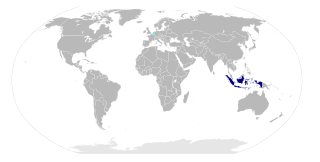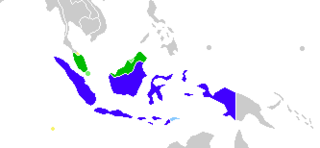
Indonesian is the official and national language of Indonesia. It is a standardized variety of Malay, an Austronesian language that has been used as a lingua franca in the multilingual Indonesian archipelago for centuries. With over 280 million inhabitants, Indonesia ranks as the fourth most populous nation globally. According to the 2020 census, over 97% of Indonesians are fluent in Indonesian, making it the largest language by number of speakers in Southeast Asia and one of the most widely spoken languages in the world. Indonesian vocabulary has been influenced by various regional languages such as Javanese, Sundanese, Minangkabau, Balinese, Banjarese, and Buginese, as well as by foreign languages such as Arabic, Dutch, Portuguese, and English. Many borrowed words have been adapted to fit the phonetic and grammatical rules of Indonesian, enriching the language and reflecting Indonesia's diverse linguistic heritage.

Malay is an Austronesian language that is an official language of Brunei, Indonesia, Malaysia, and Singapore, and that is also spoken in East Timor and parts of Thailand. Altogether, it is spoken by 290 million people across Maritime Southeast Asia.
Indonesian and Malaysian Malay are two standardised varieties of the Malay language, the former used officially in Indonesia and the latter in Brunei, Malaysia and Singapore. Both varieties are generally mutually intelligible, yet there are noticeable differences in spelling, grammar, pronunciation and vocabulary, as well as the predominant source of loanwords. The differences can range from those mutually unintelligible with one another, to those having a closer familial resemblance. The regionalised and localised varieties of Malay can become a catalyst for intercultural conflict, especially in higher education.
Tidore is a language of North Maluku, Indonesia, spoken by the Tidore people. The language is centered on the island of Tidore, but it is also spoken in some areas of the neighbouring Halmahera. Historically, it was the primary language of the Sultanate of Tidore, a major Moluccan Muslim state.

The Banjar or Banjarese is an Austronesian language predominantly spoken by the Banjarese—an indigenous ethnic group native to Banjar regions— in the southeastern Kalimantan of Indonesia. The Banjarese language is the de facto lingua franca for various indigenous community especially in South Kalimantan, as well as Central Kalimantan and East Kalimantan in general.
The Simeulue language is spoken by the Simeulue people of Simeulue off the western coast of Sumatra, Indonesia.
The Gorontalo–Mongondow languages are a group of Austronesian languages spoken in northern Sulawesi, Indonesia.
The Minahasan languages are a subgroup of the Austronesian languages spoken by the Minahasa people in northern Sulawesi, Indonesia. They belong to the Philippine subgroup.
Lawangan is an Austronesian language of the East Barito group. It is spoken by about 100,000 Lawangan people living in the central Kalimantan, Indonesia. Lawangan has a high degree of dialectal diversity.

Larantuka Malay, also known as Nagi, is a Malay-based creole language spoken in the eastern part of Flores in Indonesia, especially in Larantuka. It is a derivative of Malay which is thought to originate from Malacca. It is a language with unspecified linguistic affiliation. According to 2007 data, this language is spoken by 20,000 speakers, mainly the people of East Flores. Larantuka Malay is the mother tongue of the Nagi people. Then it also functions as a second language for several nearby communities.
Kei is an Austronesian language spoken in a small region of the Moluccas, a province of Indonesia.
The Bima language, or Bimanese, is an Austronesian language spoken on the eastern half of Sumbawa Island, Indonesia, which it shares with speakers of the Sumbawa language. Bima territory includes the Sanggar Peninsula, where the extinct Papuan language Tambora was once spoken. Bima is an exonym; the autochthonous name for the territory is Mbojo and the language is referred to as Nggahi Mbojo. There are over half a million Bima speakers. Neither the Bima nor the Sumbawa people have alphabets of their own for they use the alphabets of the Bugis and the Malay language indifferently.
Banda is an Austronesian language of the Central Maluku subgroup. Along with Kei, it is one of the two languages of the Kei Islands in the Indonesian province of Maluku.
Kendayan, or Salako (Selako), is a Malayic Dayak language of Borneo. The exact number of speakers remains unknown, but is estimated to be around 350,000.
Talaud is an Austronesian language spoken on the Talaud Islands north of Sulawesi, Indonesia. There are 2 dialects, namely Lami dialect which is spoken on Miangas, Nanusa Islands, and Esang in the northern part of Karakelang Island; Tirawata dialect is used in Lirung, Kabaruan, and the southern part of Karakelang Island.
Yonggom is one of the Ok languages of Indonesia and Papua New Guinea. According to its speakers, it is part of a continuum of 9 mutually intelligible dialects of Muyu languages which also includes Muyu, North Muyu (Kadi), South Muyu, and Ningrum. Petabahasa by Indonesian Ministry of Education classified this language as Yonggom/Yongkom(BPS:1158 6) spoken in Kampung Ninati, although another name recorded for South Muyu(BPS:0917 2) is Yongon.
Alune is an Austronesian language of west Seram in the Maluku archipelago of Indonesia.
Suwawa is a Philippine language spoken in North Sulawesi (Celebes), Indonesia. It is also known as Bonda, Bone, Bunda, Bune, Suvava, and Toewawa. The language mostly spoken in Suwawa District, Regency of Bone Bolango.
Moma is an Austronesian language spoken in Central Sulawesi, Indonesia. Historically, it is derived from the Kaili dialect cluster, but is divergent due to strong influence from Uma.
Wakasihu, or Larike-Wakasihu after the two still-vigorous dialects, is an Austronesian language of Ambon Island in the Maluku Islands.





